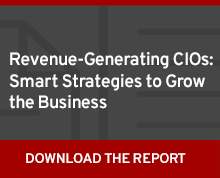IT leaders have heard a direct order from CEOs for the past several years: Go make money. With considerable power to tap into a company’s digital advantages, the CIO is becoming seen as the “competitive capabilities champion,” according to Martha Heller, CEO of Heller Search Associates and author of Be the Business: CIOs in the New Era of IT. Successful IT leaders are shaping new data-based services, software products, and other items that create new revenue streams.
How do these CIOs pull it off? After all, you must inspire great cultural change on the IT team. You also need to change the ways you develop ideas and measure success.
Our recent Harvard Business Review Analytic Services report, for which Abbie Lundberg interviewed 15 CIOs succeeding on the revenue front, found that all of them had moved their IT teams from a project-ownership mentality to a product-ownership mentality. (Download the full report, Revenue-generating CIOs: Smart Strategies to Grow the Business.)
These CIOs cite three key aspects to getting teams to embrace that product-ownership mentality:
- Inspiring ownership and accountability beyond the usual boundaries of project delivery
- Prioritizing the user experience, often by taking a design thinking approach
- Developing different metrics to measure success
Let’s look at how some top CIOs are making those three aspects a reality within their IT organizations.
1. Inspiring ownership and accountability
Like many CIOs, Tim Elkins, CIO at PrimeLending, led an IT group that had long been organized around projects. But as the company began developing a new digital mortgage tool, Apply Now, IT made the leap to a product team. This team brought together experts from previous IT silos, such as development and QA. Managers of those specialties put up a lot of resistance to the new plan, Elkins says. But while everyone endured some discomfort and tweaks had to be made, the results now speak for themselves.

IT leaders facing cultural opposition to a move to product teams can tout benefits like the ones Elkins saw – such as enhanced opportunity for individuals to shine and improved dev process.
“It’s been about two years now without any turnover from this team, and the benefits of assembling one dedicated to a product have been significant,” Elkins says. “Everyone feels like they have the opportunity to contribute to the end result and that their voices are heard, for example. You’re part of this team all year long, year after year, instead of just a short cycle of the project. People feel ownership, and there’s a strong sense of camaraderie that there wasn’t before.”
Another benefit of the product team approach: Speed. “This has tremendously increased the speed at which we work,” Elkins says. “We’ve just moved to monthly sprints rolling out new upgrades every month, which we had a tough time doing working on the project basis.”
2. Prioritizing the user experience
Mojgan Lefebvre, CIO of the Global Specialty business unit at Liberty Mutual, leads an IT organization where IT is “involved from the start in ideation, managing development (increasingly as part of a multi-functional agile team), and providing ongoing service and support for diverse users once the product goes live – basically, owning the entire life-cycle of the software product in a way that few IT organizations have in the past,” as the HBR report notes.
“A project has a beginning and end,” says Lefebvre. “The project ends when we put the product in users’ hands.”
Liberty Mutual uses a design thinking approach to shape its IT development, prioritizing three core areas: a product’s desirability to customers, its feasibility from a technical perspective, and its viability as a business venture.
Design thinking isn't the only way to emphasize customer experience, of course. For example, Curt Carver, CIO at the University of Alabama at Birmingham, uses crowdsourcing “to create a voice for the customer and allow them to coauthor solutions.” Crowdsourcing helps his IT team hear what the customer needs and prioritize solutions accordingly, he says.
3. Developing different metrics to measure success
At Land O’Lakes, IT has moved well down the path of revenue generation. For example, the R7 Tool by WinField United, a software platform born from a partnership between CIO Mike Macrie and WinField EVP and COO Mike Vande Logt, “provides advanced, near-real-time capabilities for farmers to analyze the history and productivity of their fields and to select the right seeds ... Accessed through a mobile device, it helps both retailers and farmers in the field make better decisions and react faster to changing conditions,” as the HBR report notes.
“My product managers own the product from birth to death,” Macrie says. “And their main goals are whatever objectives the business has set out for them. We’ve got to build the right thing, and we’ve got to get it adopted by our customers. If it is exclusively a revenue-generating opportunity, they’re also aligned incentive-wise toward generating that revenue.”
IT people on such a team are measured on metrics like time to market, creativity, customer intimacy, and customer adoption rates, he notes. That’s a far cry from traditional IT metrics that emphasized reducing costs. Of course, businesses still expect IT to do cost-efficient operations work, and Macrie segments his department into groups, with varying metrics, to hit those expectations.
For much more on the strategies of revenue-generating CIOs, download the full report.





